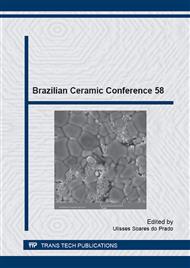p.293
p.297
p.303
p.309
p.315
p.320
p.325
p.330
p.335
Evaluation of Morphology and Roughness of the Surface of a Ceramic Based on Lithium Disilicate, after Conditioning with Acid Hydrofluoric the 5% and 10%
Abstract:
The aim of the study was to evaluate the difference in the surface of dental ceramics, the basis of lithium disilicate, varying the concentration and time of application of the acid. Samples of IPS e.max Press (Ivoclar) were divided into: G1-control; G2 hydrofluoric acid 10% - 20 sec; G3 hydrofluoric acid 10% - 40 sec; G4 hydrofluoric acid 5% - 20 sec G5 and hydrofluoric acid 5% - 40 sec. The samples were analyzed under SEM (Carl Zeiss) confocal microscope and (Carl Zeiss). The qualitative morphologic analysis showed that 40 seconds of conditioning promoted the dissolution of the vitreous component and the ceramic crystal display for the two concentrations. Hydrofluoric acid 10% showed higher values of roughness. One can conclude that conditioning for 40 seconds is more effective than the 20 seconds for the two concentrations hydrofluoric acid and 10% promoted a higher surface roughness in the ceramic.
Info:
Periodical:
Pages:
315-319
Citation:
Online since:
June 2015
Keywords:
Price:
Сopyright:
© 2015 Trans Tech Publications Ltd. All Rights Reserved
Share:
Citation:


